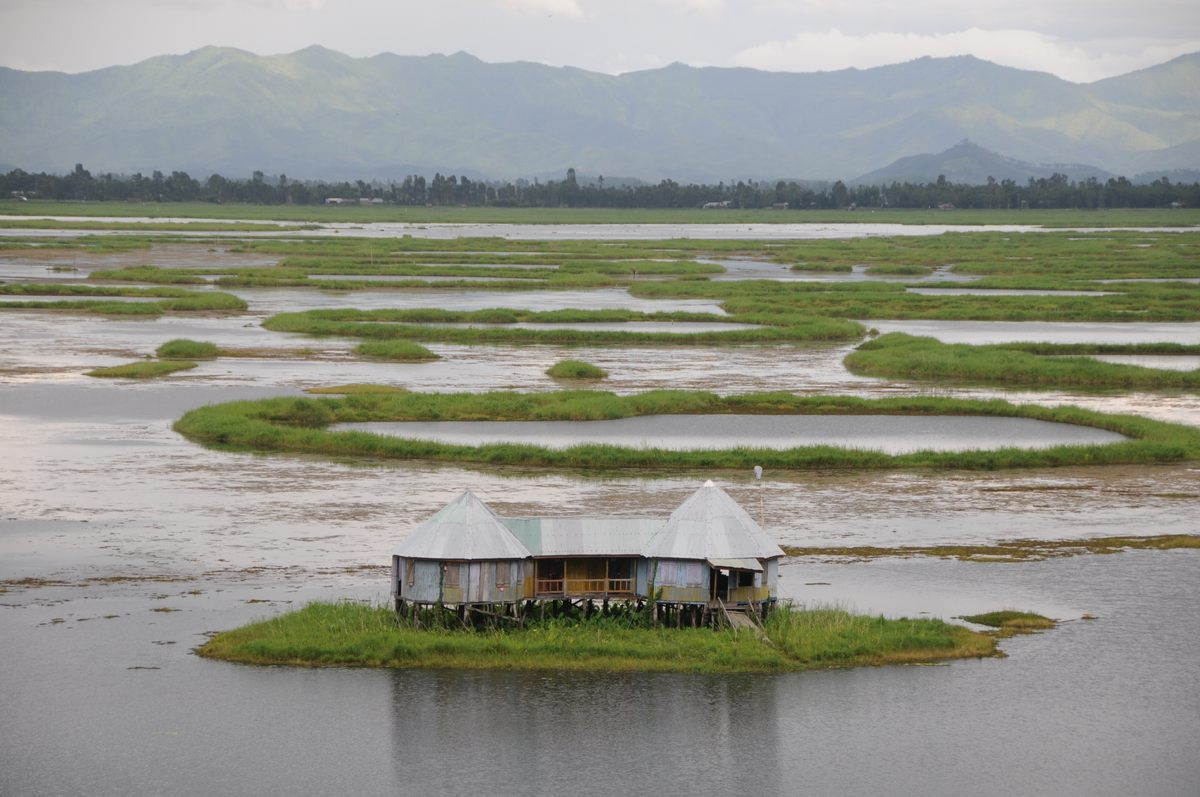This story was originally published by Atlas Obscura and appears here as part of the Climate Desk collaboration.
Are these geometric doodles of chartreuse against a much deeper green? Or an array of empty frames hung pell-mell on a dark wall? Zoom in on a few of the tiny white rectangles scattered across the image for a sense of scale: You’ll see they’re small homes. You’re looking at an aerial view of some of the famous floating islands of northeast India’s Loktak Lake. The image is also a snapshot of a moment in the story of a wondrous and unique environment that’s undergoing enormous change.
Not far from the border with Myanmar, Loktak is one of the largest lakes in South Asia. It covers about 100 square miles — but that was not always the case. Before the construction of a large dam raised the lake’s water levels permanently, Loktak’s dimensions used to change dramatically with the seasons: During the dry months, it shrank to about half its current size. While that may sound like an inconvenience for the tens of thousands of people who rely on the lake for water, fish, and other resources, the fluctuating levels played a crucial role in preserving an unusual ecosystem.
Those eye-catching floating islands, or phumdis, are just the tops of much thicker mats of soil and vegetation. Phumdis can form naturally, but many have been shaped by humans. Fishers and other locals sometimes float lengths of ropes in the water to create a kind of frame where organic material can collect over time, eventually creating a new living island. Thousands of phumdis float on the lake year-round now, which is a problem. Before the dam, when lake levels fell in the dry season, roots on the undersides of the phumdis would come in contact with the lake bed and soak up needed nutrients. Now, without that seasonal sustenance, many of the phumdis have started to break apart.
This is just one of the challenges that the dam and other infrastructure projects have brought to the area. In 2017, the Pulitzer Center reported that many native fish species disappeared from the lake after the dam became operational in the 1980s. In response, according to international wetlands monitor Ramsar, the government stocked the lake with non-native species, including voracious silver carp, which further upset the ecosystem. Agricultural runoff, pesticide use, and other human activities have only aggravated the problem. Harvests of locally grown varieties of rice and other food resources, such as the highly nutritious heikak, or water chestnut, have dwindled or disappeared.

In the last decade, there’s been a grassroots effort to have the dam decommissioned and the lake’s natural cycle restored, but it would be an unprecedented event — and an unlikely one. Hydroelectricity generated at the dam is the main source of power for the entire state of Manipur, which has a population of more than three million and counting.
While the fate of the floating islands and the roughly 100,000 people who depend on the lake is uncertain, Loktak remains, for now, a place of otherworldly wonder. Photographer Aakash Selvan travelled more than 1,000 miles from his home in southern India to photograph the phumdis as part of a larger project to showcase the country’s diverse natural beauty.
“My wish is to document 100 different aerial perspectives of India,” says Selvan, whose image, Floating Islands, was recognized as “Highly Commended” in a recent Drone Photo Awards competition. “I spend hours on Google Earth, trying to find subjects,” he says, “I struck gold when I found these.”
Selvan adds that, at lake level, the phumdis appeared “endless.” And walking or standing on them was also memorable. “It’s almost like a trampoline; all of these phumdis are bouncy,” he says.
With local communities and scientists alike calling for greater protections for the lake and its unique ecosystem, the phumdis may yet bounce back.






Comments